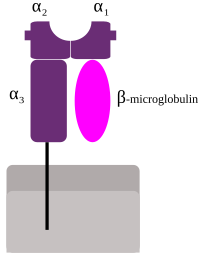
Photo from wikipedia
We investigated the impact of donor-recipient HLA-DPB1 matching on outcomes of allogeneic hematopoietic stem cell transplantation with in vivo T-cell depletion using antithymocyte globulin (ATG) for patients with hematological malignancies.… Click to show full abstract
We investigated the impact of donor-recipient HLA-DPB1 matching on outcomes of allogeneic hematopoietic stem cell transplantation with in vivo T-cell depletion using antithymocyte globulin (ATG) for patients with hematological malignancies. All donor-recipient pairs had high-resolution typing for HLA-A, HLA-B, HLA-C, HLA-DRB1, HLA-DQB1, HLA-DPB1, and HLA-DRB3/4/5 and were matched at HLA-A, HLA-B, HLA-C, and HLA-DRB1. HLA-DPB1 mismatches were categorized by immunogenicity of the DPB1 matching using the DPB T-cell epitope tool. Of 1004 donor-recipient pairs, 210 (21%) were DPB1 matched, 443 (44%) had permissive mismatches, 184 (18%) had nonpermissive mismatches, in graft-versus-host (GVH) direction, and 167 (17%) had nonpermissive mismatches in host-versus-graft (HVG) direction. Compared with HLA-DPB1 permissive mismatched pairs, nonpermissive GVH mismatched pairs had the highest risk for grade II to IV acute graft-versus-host disease (aGVHD) (hazard ratio [HR], 1.4; P = .01) whereas matched pairs had the lowest risk (HR, 0.5; P < .001). Grade III to IV aGVHD was only increased with HLA-DPB1 nonpermissive GVH mismatched pairs (HR, 2.3; P = .005). The risk for disease progression was lower with any HLA-DPB1 mismatches, permissive or nonpermissive. However, the favorable prognosis of HLA-DPB1 mismatches on disease progression was observed only in peripheral blood stem cell recipients who were in the intermediate-risk group by the Disease Risk Index (HR, 0.4; P = .001) but no other risk groups. Our results suggest avoidance of nonpermissive GVH HLA-DPB1 mismatches for lowering the risk for grade II to IV and III to IV aGVHD. Permissive or nonpermissive HVG HLA-DPB1 mismatches may be preferred over HLA-DPB1 matches in the intermediate-risk patients to decrease the risk for disease progression.
Journal Title: Blood
Year Published: 2018
Link to full text (if available)
Share on Social Media: Sign Up to like & get
recommendations!